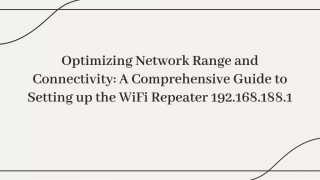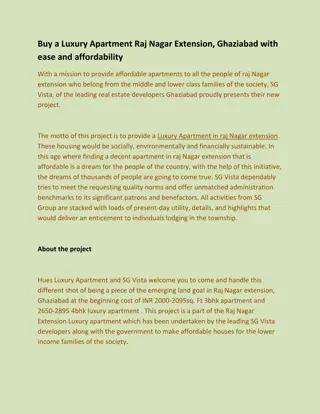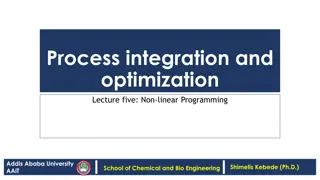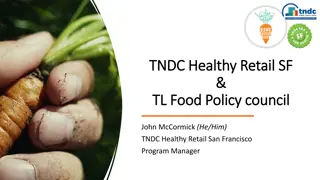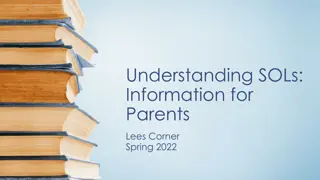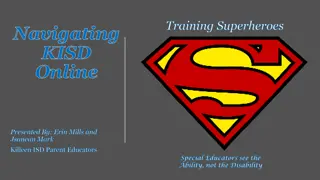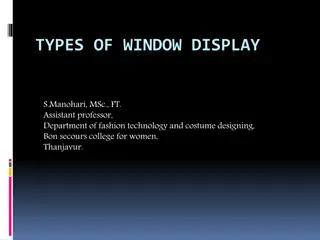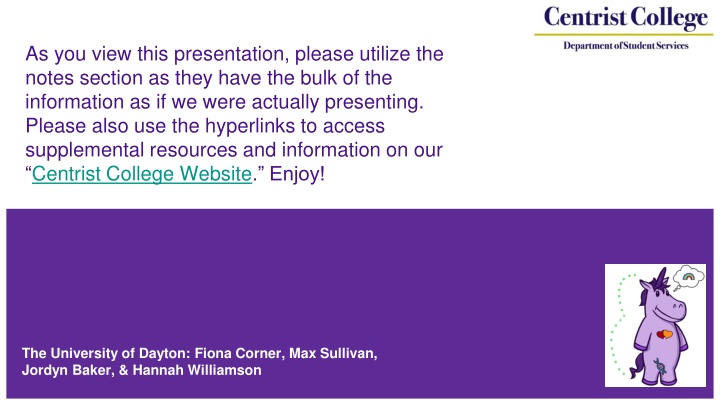
Demystifying Transgender Student Experience at Centrist College
This presentation delves into the importance of understanding and supporting transgender students on campus. It challenges common myths and misconceptions, emphasizing the need for inclusivity and action. The agenda includes recognizing various pronouns, debunking binary gender norms, and creating strategies for inclusion. With a focus on education and empowerment, the seminar aims to equip participants with tools to better support transgender students.
Download Presentation

Please find below an Image/Link to download the presentation.
The content on the website is provided AS IS for your information and personal use only. It may not be sold, licensed, or shared on other websites without obtaining consent from the author. If you encounter any issues during the download, it is possible that the publisher has removed the file from their server.
You are allowed to download the files provided on this website for personal or commercial use, subject to the condition that they are used lawfully. All files are the property of their respective owners.
The content on the website is provided AS IS for your information and personal use only. It may not be sold, licensed, or shared on other websites without obtaining consent from the author.
E N D
Presentation Transcript
As you view this presentation, please utilize the notes section as they have the bulk of the information as if we were actually presenting. Please also use the hyperlinks to access supplemental resources and information on our Centrist College Website. Enjoy! The University of Dayton: Fiona Corner, Max Sullivan, Jordyn Baker, & Hannah Williamson
The Gender Unicorn: Demystifying the Transgender Student Experience Centrist College Senior Staff Development Series www.centristcollege.edu The University of Dayton: Fiona Corner, Max Sullivan, Jordyn Baker, & Hannah Williamson
Agenda & Learning Goals Learning Outcomes As a result of this professional development seminar, participants will be able to: 1. Recognize and define the various pronouns available for students identify themselves and recognize the belief that gender does not exist on a binary. 2. Identify the importance of providing transgender students support on campus. 3. Create an action plan to implement presented strategies to address the inclusion of transgender students on campus. 4. Utilize multiple resources and future seminar topics to continue their education about transgender students. Agenda Throughout this presentation, we will deconstruct the following myths: 1. This doesn t matter 2. There s only binary 3. This isn t an issue in Higher Education 4. This isn t an issue at Centrist 5. We don t have transgender students on campus 6. Transgender students should teach us 7. Allies don t do that much 8. Students don t care 9. I can t do anything 10.Centrist is doing enough And present an Action Plan for the division, within offices, and one-on-one interactions
This doesnt matter *This impacts every part of campus from admissions to zoology For the humanitarian... For the politician This is a political movement, similar to but not the same as, gay and lesbian rights. This movement is powerful and we want to be on the winning side. Our students are struggling to understand their own identity and they are not feeling welcomed to do so on our campuses. For the lawyer... For the intellectual These students are our customers just as much as other students are. They have the same rights to safety and security as others. The students are developing their identity and discovering their self-authorship.
Theres only the binary! *For some, gender does not exist as only male & female, there are many options (more than are even listed here!) Gender nonconforming Gender Cisgender Sex Agender Transgender Gender Privilege MTF Transgender Ze, Hir/Zir, Hirs/Zirs FTM Transgender Intersex Genderqueer
This isnt an issue in Higher Education * One fifth of transgender students have not been offered housing that supports their gender identity (Erbentraut) Many higher education institutions currently have policies that negatively impact this population Official documentation contains student s given name and biological sex Can lead to unintentionally outing studentsto the general population through professors accidently using the given name the first day of classes and the university ID having this incorrect information (Beemyn, Curtis, & Davis, 2005) College housing operates within the structure of a gender binary with same sex rooms and same sex restrooms Most housing departments lack a system to meet these students housing needs through the housing application and facilities (Beemyn, Curtis, & Davis, 2005) 39% of transgender students, faculty, and staff encounter harassment and/or discrimination in the college setting (Krum, Davis, & Galupo, 2013)
This isnt an issue at Centrist * One fifth of transgender students have not been offered housing that supports their gender identity (Erbentraut) Campus culture and LGBTQ* support Our Office of LGBTQ* Support Serviceswhich was founded during Fall of 2014 is located in the lower level of the Womyn s Center One professional staff member and two graduate assistants Through recent data collected from our Coordinator of Assessment and Planning, the committee has learned the following: 74% of Centrist students are not aware of the issues of the LGBTQ* community on the Centrist College campus 12% of students know of the Office of LGBTQ* Support Services 7% of students recognize the LGBTQ* support services that Centrist provides Through qualitative data, we learned that effective strategies have been created to support the Office of LGTBTQ* Support Services, but the office still has room to grow and better supportthe needs of the transgender community
We dont have any transgender students on campus * There are nearly 700,000 individuals who identify as transgender in the nation (U.S. Census Bureau, 2015) Screen Shot 2016-02-26 at 7.03.17 PM.png Please click on the image.
Transgender students should teach us *Instead take it upon yourself to do some research and read about Transgender student experiences. Not all Trans people want surgery and even fewer people get surgery. 5 things you should know about the Transgender population Not all trans people identify as male or female. The word Transgender was popularized by activist Virginia Prince. Trans people led the Stonewall riots. Trans folks have many different sexual orientations Adapted from Trans Student Educational Resources
Allies dont do that much * Creating an inclusive community for transgender students is trending amongst college campuses. Allies actively supporting this population. Here are some creative and trending ways colleges and staff are supporting the transgender community. Welcomes transgender students Adding inclusive language to mission and policy Provides an inclusive environment Provides resources Have a support network Are academics in the field
Students dont care * Student identity and sense of belonging is affected by the environment they are involved in as they develop. According to Baxter Magolda s study (2004), undergraduate students rely heavily on external sources of authority (p. 147) which places a significant amount of power to us, the authority, to lay a foundation on which they make decisions about their and other s identities. As development occurs during this time, students are moving towards self- authorship which they develop skills to take in and use external information, their own experiences and judgement to define their identities, beliefs and how they relate to others (p. 148). As professionals working in Higher Education, we must provide an environment of challenge and support for active positive development leading to self-authorship (Baxter Magolda, 2004). To do this, we must provide transgender students by validating their experience and co-constructing programs that include their voice (Baxter Magolda, 2004).
Students dont care * Student identity and sense of belonging is affected by the environment they are involved in as they develop. Marginality and Mattering--including and appreciating transgender students on campus Mattering is people s belief, whether wrong or right, that someone appreciates and cares for them, and that they are the object of someone s attention (Schlossberg, Lynch, and Chickering, as cited in Johnson, 2012, p. 79). Creating a space of mattering counteracts the feelings of marginality transgender students might feel on campus--students who feel marginalized will not engage in campus activities or succeed academically as greatly as possible (Beatty, Bottoms, & Gray, 2011). To encourage participation, recognize the apprehension students might have, provide small opportunities at first, do not pretend to understand their experience, & place engagement as important for collegiate and post collegiate life.
I cant do anything *YOU can always do something. Even if it seems small and insignificant to you, it IS significant to our students. If anything at all, at LEAST do these things... Use the name and pronouns people ask to be called. Always. If you ve met a student after their transition, don t ask to see before pictures or ask their previous name. Don t compliment people by telling them they look like a real [gender] . Don t make assumptions about students sexual orientation. Visit the Centrist College website to learn about Transgender Tuesdays. A series of workshops sponsored by the Department of Student Services.
Centrist is doing enough *Centrist College has an assortment of programs already, but there is always room to grow. Here are some possibilities. Resources Passive Marketing Campaign
Action Plan *There needs to be a structure in place for continuous improvement. Here is the action plan moving forward. Department-wide Initiatives Campus Climate Assessment Raise professional development competencies through workshops, resources, and continued education Re-write policies with more gender inclusive language and a concerted effort to be more inclusive of all gender identities Initiate an in-office campaign to create a more inclusive environment (i.e.) Gender inclusive language and images in marketing End of the year office awards for student inclusive support DAT Transgender Tuesdays work group
Action Plan *There needs to be a structure in place for continuous improvement. Here is the action plan moving forward. Office-Specific Initiatives Collaboration with other offices across campus including but not limited to the LGBTQ* office to support transgender students Re-write policies, procedures, and marketing materials with more gender inclusive language and images Educating student workers around transgender and non-binary student identities and building creating inclusive environments Admissions Office -Allow students to self select their own pronouns on documents Office of Student Involvement and Programming - Late Night programming specifically during Transgender Awareness Month (November) -Educate student leaders and organizations on inclusion and inclusive environments Housing and Residence Life - Assess the ability to create gender neutral restrooms and a plan for the transition to it -Establish a LGBTQ Learning Living Community
Action Plan *There needs to be a structure in place for continuous improvement. Here is the action plan moving forward. One-on-One Interactions Working to develop trusting relationships with transgender and non-binary students Develop change agents Bystander intervention/ally training Education for all students on bias related incidents and how to report them Challenging students to think about the binary gender construct and their beliefs connected to it
References Baxter Magolda, M.B. & King, P.M. (2004). Learning partnerships: Theory and models of practice to educate for self-authorship. Sterling, VA: Stylus Publishing. Beatty, C., Bottoms, M., & Gray, K. (2011). Engaging students of color on campus programming. Bulletin of the Association of College Unions International 79 (3). Beemyn, B., Curtis, B., & Davis, M. (2005). Transgender Issues on College Campuses. Gates, G. J., & Ost, J. (2011). The gay & lesbian atlas. Washington, D.C.: Urban Institute Press. Johnson, J. M. (2012). Mattering, marginality, and feminist theory: Moving to empower black women. Vermont Connection 33, 76-85. Krum, T. E., Davis, K. S., & Galupo, M. P. (2013). Gender-Inclusive Housing Preferences: A Survey of College-Aged Transgender Students. Journal of LGBT Youth, 10(1/2), 64-82. doi:10.1080/19361653.2012.718523. McKinney, J. S. (2005). On the Margins: A Study of the Experiences of Transgender College Students. Journal of Gay & Lesbian Issues In Education, 3(1), 63-75. Schnetzler, G. W., & Conant, G. K. (2009). Changing Genders, Changing Policies. Chronicle of Higher Education, 56(8), B30-B32. Seelman, K. L. (2014). Recommendations of transgender students, staff, and faculty in the USA for improving college campuses. Gender & Education, 26(6), 618-635. doi:10.1080/09540253.2014.935300 Seelman, K. L. (2014). Transgender Individuals Access to College Housing and Bathrooms: Findings from the National Transgender Discrimination Survey. Journal of Gay & Lesbian Social Services, 26(2), 186-206. doi:10.1080/10538720.2014.891091 Tilsley, A. (2010). New Policies Accommodate Transgender Students. Chronicle of Higher Education, 56(39), A19-A20. Transgender: By the numbers. (n.d.). Retrieved November 10, 2015, from http://www.timesunion.com/local/article/Transgender-by-the-numbers- 2342726.php
Thanks for joining us! For more information please visit the Centrist College website.

